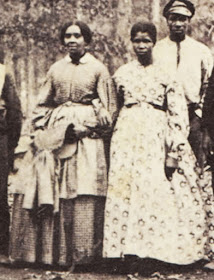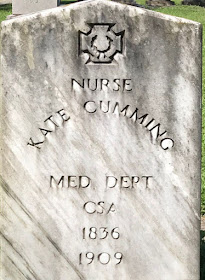Hospital Sketches #6 Mountain Laurel by Becky Brown
This popular applique block recalls a hotel turned hospital in Corinth, Mississippi in the Appalachian foothills.
Laurel blocks appear quite often in album samplers.
Several Southern plants are known as Mountain Laurel.
Mountain Laurel by Myrna Powers
Cross the stems or leave the center empty
The Tishomingo Hotel was successively a hospital for both Confederate and Union wounded, changing allegiance as the important railway junction was occupied by different armies during the war. Confederate soldiers were treated there after the Battle of Shiloh in April, 1862 until Union forces took over Corinth six months later.
Confederate Kate Cumming served there:
"We are at the Tishomingo Hotel, which, like every other large building, has been taken for a hospital. The yellow flag is flying from the top of each.
Kate Cumming (1836-1909)
Mrs. Ogden tried to prepare me for the scenes which I should witness upon entering the wards. But alas! nothing that I had ever heard or read had given me the faintest idea of the horrors witnessed here."
Tishomingo Hotel along the railroad tracks
Like many women, Kate had to defy convention to work in a hospital. Born in Scotland she was raised in Mobile, Alabama. Southern women, in particular, were thought too delicate for such work. Cosseted by slaves, trailed by chaperones, married in their teenage years, they were considered inept at anything but decorative mothering.
"The Lady with the Lamp," Florence Nightingale
was the model for American women after her
innovative soldiers' care.
At war's beginning, Kate joined a group of women calling themselves the Florence Nightingale Brigade after the inspiring nurse in England's Crimean War. According to a 1914 book by Richard J. Fraise, Kate's Brigade arrived at Tishomingo in the midst of chaos, "held a council of criticism and decided to revolutionize the bad management. In less than a week, however, only two or three of the thirty were left to give a helping hand. One was Miss Cumming of Mobile."
Ella King Newsom Trader (1838-1919)
This statement fifty years after the war gives you a picture of the place of slaves (always called servants in the South) in one's personal litany of identity and possessions. Confederates sent supplies, food and enslaved workers to help.
"Nurses are very much wanted and citizens who can spare their servants are requested to send them to the camp." Richmond Whig May 10, 1862.
Mary and Delia were possibly free black women working
at the Armory Square Union Hospital in Washington.
From Sarah Low's scrapbook.
Ella recalled boarding in Corinth in a sparsely furnished room. "I was allowed to occupy with my faithful servant Carrie a small room in which we put two cots and one or two boxes for seats."
African-American women pose for a photo over the yard
of a Nashville hospital, summer, 1863.
Mountain Laurel by Bettina Havig
Kate Cumming and Ella Newsom became friends and saw each other at various postings throughout the war. Ella seems to have always been accompanied by "servants" who helped forage for food, carry supplies, and nurse patients in Confederate hospitals.
Escaped slaves, "contraband" workers assisting
the 13th Massachusetts Infantry
Mountain Laurel by Barbara Brackman
I put the leaves atop the stem
The role of African-Americans in hospitals has long been invisible. Reading Kate Cumming's journals one sees them on the periphery, slipping in and out of the picture. Although born in Scotland, Kate adopted Southern prejudices towards the "servants" who waited on her, helped her and carried out her nursing mission. A search for the word "servant" in her online diary reveals some of the duties of men and women as cooks, laundry workers and nurses.
Unknown woman photographed during the war by
Jacob Byerly of Frederick County, Maryland.
Ross J. Kelbaugh Collection
In March 1865 at a hospital in Macon, Georgia, patients were few and she had to turn down several women looking for work.
"We have many Negroes, and nothing for them to do but sewing...A number...are at work quilting comforts. Dr. de Yampert wished to have the cloth for them dyed; but most of the Confederate dye does not stand. The comforts are made out of unbleached homespun, and the raw cotton is put in them in lumps, and they are tacked about a foot apart; when washed they are not fit to use."
African-American workers outside the laundry at the Nashville hospital.
Comforters on the line seem to be of the type Kate described.
Glenna R. Schroeder-Lein in her Encyclopedia of Civil War Medicine cites records for Georgia Confederate hospitals. Blacks were about 46% of all hospital workers in 1863 and 70% the following year. Union women hospital workers were 10% black with 36% of the cooks, 14% of the laundresses and 6% of the nurses African Americans.
Another view of the laundry in Nashville.
The women's dresses seem quite revealing,
probably because they are wet.
Much variety in the block but the basic structure is four
twigs of compound leaves in green and red.
See a post on the block's history here:
To Print:
Create a word file or a new empty JPG file.
Click on the image above.
Right click on it and save it to your file.
Print that file. Be sure the square is about 1" in
size.
Cutting:
For the background cut a square 18-1/2".
For the background cut a square 18-1/2".
Add seam allowances to the pattern pieces if you are
doing traditional applique.
The empty spot in the center requires some thinking about negative space.
There are three ways to do this.
1) Start placement in the block corners with the red leaves and work towards the center. Then adjust the leaves so both the corners and the centers are symmetrical.
1) Start placement in the block corners with the red leaves and work towards the center. Then adjust the leaves so both the corners and the centers are symmetrical.
2) Start at the center by making a diagonal line about 5-1/2" long (very lightly with a #2 pencil) using your grid ruler for placing the inside green leaves.
3) Cut yourself a piece of paper 5-1/2" square. Place it on the diagonal in the center of the block. Line up those center green leaves along the edges and work out towards the corners.
Mountain Laurel by Janet Perkins
Vintage quilt with a lot of leaves
Addition
Mountain Laurel by Roseanne Smith
Crossed stems fill up the center.
Roseanne made each of her leaves separately.
Mountain Laurel by Becky Brown with dots
Subtraction
8-1/2" x 8-1/2" Finished
Cut a 9" square
1 Each of A, B & C
1/2” Finished bias stem
A bit more information about Caroline Elizabeth (Carrie) is included in Ella Newsom's biography. She'd entered the Newsom's home when she was nine coming from Ella's parents house in Arkansas. After the war and freedom she married a man named Baker and moved to Madison County, Illinois, where she had six children. This is not much but it is more information that easily found on the rest of the women of color seen here.
1/2” Finished bias stem
Denniele Bohannon's #6 Laurel Sprout
Finishes to 9"
Finishes to 9"
Subtraction and addition
The block has no directionality so it goes in the center of the outside row.
After the War
Sampler from an online auction
After the war Ella King Newsom married Colonel William H. Trader of the Arkansas Volunteers who had been a patient in Nashville. Perhaps they met there. She and Trader had children, one of whom May survived into adulthood. The marriage was apparently not happy as the 1880 census finds William living in a Memphis hotel listed as single while Ella was living in Asheville, North Carolina. She later moved to Washington to work as a government clerk.
In 1910 she was run over by an express wagon according to the magazine Confederate Veteran, which suggested readers help her out. Women like Ella were the beneficiaries of the many Confederate veteran's charities into the 20th century. She died in 1919 at May's home. May who never married also worked for a Washington government agency.
Mountain Laurel by Barb Sanders
In 1910 she was run over by an express wagon according to the magazine Confederate Veteran, which suggested readers help her out. Women like Ella were the beneficiaries of the many Confederate veteran's charities into the 20th century. She died in 1919 at May's home. May who never married also worked for a Washington government agency.
Kate Cumming is buried in Mobile
Kate Cumming remained single and worked as a governess and a teacher after the war. She published her memoir in 1866, but apparently did not make the kind of royalties that women like Aunt Becky Young and Clara Barton did. One had to market the book as well as write it and Kate's Confederate story undoubtedly had fewer eager readers than triumphant tales by Union heroines.
She published a second version of her memoirs in 1895.
Mountain Laurel by Kathryn Jones
Extra Reading:
Read Kate Cumming's account of her hospital days in A Journal of Hospital Life in the Confederate Army of Tennessee from the Battle of Shiloh to the End of the War.
https://books.google.com/books?id=taiAM-MQ_GUC&printsec=frontcover&source=gbs_ge_summary_r&cad=0#v=onepage&q&f=false
Read more about a variety of women hospital workers in Women at the Front: Hospital Workers in Civil War America by Jane E. Schultz
More discussion of the pattern:
http://barbarabrackman.blogspot.com/2015/05/baltimore-album-quilts-3x3.html
http://barbarabrackman.blogspot.com/2015/05/laurel-leaves-or-photinia.html
http://barbarabrackman.blogspot.com/2015/07/pattern-names-romance-revision.html
Read more about a variety of women hospital workers in Women at the Front: Hospital Workers in Civil War America by Jane E. Schultz
Texas Laurel leaf
More discussion of the pattern:
http://barbarabrackman.blogspot.com/2015/05/baltimore-album-quilts-3x3.html
http://barbarabrackman.blogspot.com/2015/05/laurel-leaves-or-photinia.html
http://barbarabrackman.blogspot.com/2015/07/pattern-names-romance-revision.html




































Thank you for another insightful story and terrific block.
ReplyDeleteI liked the phrase "decorative mothering." Thank you for another interesting article!
ReplyDeleteLove this block. Especially love what Betina did!
ReplyDeleteI'm 55-year-old from Korean, I was diagnosed with second-stage liver cancer following a scheduled examination to monitor liver cirrhosis. I had lost a lot of weight. A CT scan revealed three tumors; one in the center of my liver in damaged tissue and two in healthy portions of my liver. No chemotherapy or radiotherapy treatment was prescribed due to my age, the number of liver tumors. One month following my diagnosis I began taking 12 (350 point) Salvestrol supplements per day, commensurate with my body weight. This comprised six Salvestrol Shield (350 point) capsules and six Salvestrol Gold (350 point) capsules, spread through the day by taking two of each capsule after each main meal. This level of Salvestrol supplementation (4,000 points per day) was maintained for four months. In addition, I began a program of breathing exercises, chi exercises, meditation, stretching and stress avoidance. Due to the variety of conditions that I suffered from, I received ongoing medical examinations. Eleven months after commencing Salvestrol supplementation But all invalid so I keep searching for a herbal cure online that how I came across a testimony appreciating Dr Itua on how he cured her HIV/Herpes, I contacted him through email he listed above, Dr Itua sent me his herbal medicine for cancer to drink for two weeks to cure I paid him for the delivering then I received my herbal medicine and drank it for two weeks and I was cured until now I'm all clear of cancer, I will advise you to contact Dr Itua Herbal Center On Email...drituaherbalcenter@gmail.com. WhatsApps Number...+2348149277967. If you are suffering from Diseases listed below, Cancer, HIV/Aids, Herpes Virus,Bladder cancer,Brain cancer,Colon-Rectal Cancer,Breast Cancer,Prostate Cancer,
ReplyDelete?Esophageal cancer,?Gallbladder cancer,Gestational trophoblastic disease,Head and neck cancer,?Hodgkin lymphoma
?Intestinal cancer,Kidney cancer,Leukemia,Liver cancer,Lung cancer,Melanoma,Mesothelioma,?Multiple myeloma,?Neuroendocrine tumors,Non-Hodgkin lymphoma,?Oral cancer,Ovarian cancer,?Sinus cancer,Skin cancer,Soft tissue sarcoma,Spinal cancer,Stomach cancer,Testicular cancer,Throat cancer,Thyroid Cancer,?Uterine cancer,Vaginal cancer,Als,Vulvar cancer,Hepatitis, Chronic Illness. Lupus,Fibromyalgia.